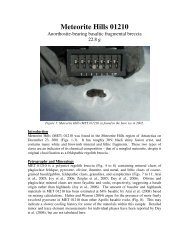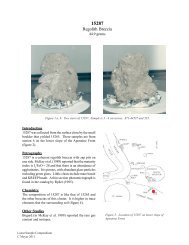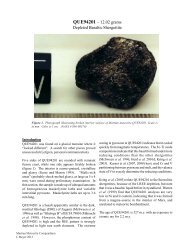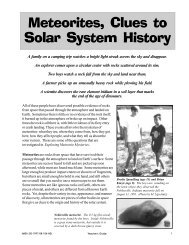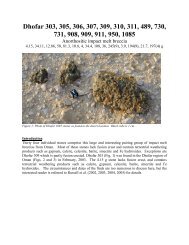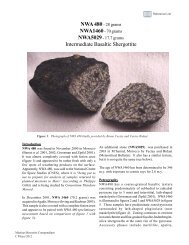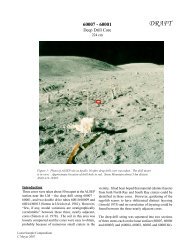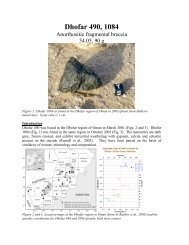Yamato 82192, 82193, 86032
Yamato 82192, 82193, 86032
Yamato 82192, 82193, 86032
Create successful ePaper yourself
Turn your PDF publications into a flip-book with our unique Google optimized e-Paper software.
<strong>Yamato</strong> <strong>82192</strong>, <strong>82193</strong>, <strong>86032</strong>Anorthositic fragmental breccia37, 27, 648 gFigure 1: <strong>Yamato</strong> <strong>86032</strong> in the meteorite laboratory at the NIPR (from Yanai et al., 1987).Introduction<strong>Yamato</strong> <strong>86032</strong> (Fig. 1) was discovered December 9, 1986 during the 27 th JARE in the <strong>Yamato</strong>Mountains (Figs. 2 and 3). It was recognize as similar to <strong>Yamato</strong> <strong>82192</strong> and <strong>82193</strong>, as well as inclose proximity. Preliminary examination (Yanai et al., 1987) showed it is an anorthositicbreccia. In contains numerous white to grey clasts as well as impact melt veins and deep narrowcavities. It was allocated to 25 international investigators as part of a consortium.PetrographyModal mineralogy and detailed petrographic descriptions of the <strong>Yamato</strong> 86/82 reveal theirsimilar clast mineral content (Table 1). All three meteorites contain matrix that is glass rich,with minor amounts of fine grained mineral clasts including olivine, pyroxene and plagioclase.Clasts present in these meteorites include subophitic impact melt clasts, feldspathic and maficimpact melt clasts and granulitic breccias. All clasts reported so far are feldspathic with a fewexceptions: basaltic clasts in Y-<strong>82193</strong> (Takeda et al., 1987), and Y-<strong>86032</strong> (Yamaguchi et al.,2004, 2008). Typical textures are illustrated in thin section photomicrographs from the NIPRPhotographic Catalog (Fig. 4 to 6; Yanai et al., 1987), sketches and images taken by Bischoff et1
al. (1987) for the <strong>Yamato</strong> <strong>82192</strong> and <strong>82193</strong> paired stones (Figs. 7 and 8), and images of a slab of<strong>Yamato</strong> <strong>86032</strong> studied by Takeda et al. (1999) (Figs. 9 and 10).Figure 2: Location map for the <strong>Yamato</strong> MountainsFigure 3: Detailed location map for the <strong>Yamato</strong> lunar meteorites (courtesy of NIPR). The Y<strong>86032</strong> andpaired meteorites are near the bottom of the map.Figure 4: Plane polarized light (top) and crossed polars (bottom) photomicrographs of section 51-1 of Y-<strong>86032</strong> (from the NIPR Photographic Catalog; Yanai et al., 1987), illustrating a polymict breccia withfeldspar-rich lithic and mineral clasts set into a dark matrix. The largest clast is feldspathic, fine-grainedand 5 mm across.2
Siegerehrung und PreisverteilungSonntag, 5. Oktober 2008 unmittelbar nach Ende der Rennen.Preise je Klasse: Pokale für min. 30 % der Teilnehmer jeder KlasseOffizielle:Gesamtleitung:Rennleiter:Leiter StreckensicherungRennsekretariat:ZeitnahmeTechnikSchallpegelmessung:Startaufstellung:Streckensicherung:Rennarzt:Sanitätsdienst:Streckensprecher:Schiedsgericht:Weitere Bestimmungen:Christian Reitz, DettenheimAxel Süss, StutenseeSigi LehrLaura WeißAlbert Wenz, Graben - NeudorfRoland Grether, KarlsruheUte Armbruster, KarlsruheVanessa Grether, KarlsruheReinhard Schindler, DettenheimFranz - Josef Dörfer, HockenheimTheo Roth, DettenheimTeam LiedolsheimDRK LiedolsheimDRK LiedolsheimSiegfried Lehr, DettenheimSiegfried Lehr, DettenheimManfred Weiß, DettenheimAxel Süss, StutenseeDie Bahnordnung des TC - Liedolsheim ist unbedingt einzuhalten.Das Parken auf den Zufahrtswegen von und zu der Rennstrecke ist verbotenDer Platz im Fahrerlager ist beschränkt ! Beim Einsatz von " Großzelten " ist eine gemeinsameNutzung von mehreren Fahrern nachzuweisen.Fahrzeuge und Zelte, die 2,30 m Höhe überschreiten, haben keinen Zutritt zum inneren FahrerlagerDen Anweisungen des Aufsichtspersonals ist unbedingt Folge zu leisten.Fahrerlagerordnung ( Art. 17.1 ) & Umweltschutz ( Art. 20 )Jeder Teilnehmer erhält bei der Registrierung einen Müllbeutel,darin ist der anfallende Müll zu sammeln und mitzunehmen.Das Laufenlassen der Motoren im Fahrerlager ist verboten.Im Fahrerlager besteht absolutes Rauchverbot.Das Fahren mit motorbetriebenen Zweirädern jeder Art ist auf dem gesamten Gelände verboten.Bei Zuwiderhandlungen kann der Teilnehmer mit Bahnverbot belegt werden.Kraftstoff:Die Teilnehmer sind verpflichtet, bei der Veranstaltung ausschließlich bleifreien Kraftstoff zu verwenden.Plakate, Fugblätter, Aufkleber etc. dürfen nur mit vorherigerschriftlicher Zustimmung des TCL - Vorstandes angebracht, bzw. verteilt werden.
Figure 7: Sketch maps of <strong>Yamato</strong> <strong>82192</strong> and <strong>82193</strong> showing the distribution of mineral and lithic clasts(from Bischoff et al., 1987).Figure8a: Back scattered electron image of a fine grained impact melt breccia with subophitic tovariolitic texture in <strong>Yamato</strong> <strong>82192</strong> (from Bischoff et al., 1987). Figure 8b: Plane polarized lightphotomicrograph of a recrystallized spherule embedded in a fine grained matrix in <strong>Yamato</strong> <strong>82192</strong> (fromBischoff et al., 1987).MineralogyMost mineral fragments and minerals in the clasts define a narrow range compared to many otherlunar meteorites. For example, the plagioclase compositions are all very anorthite-rich. Theolivine compositions range between Fa 20 and Fa 40 . And the pyroxenes are relatively magnesiancompared to some of the ferro-augites and ferro-pigeonites reported in other highlands brecciasand mare basalts (Fig. 11). In addition, the Mg# and An of coexisting minerals in the clasts aremore typical of ferroan anorthsites, but also include some magnesian varieties that are not withinthe Mg suite region (Fig. 12). It is important to note that the total range of mineral compositionsis quite high, from Fa 16-93 olivine, and Mg# 0.38 to 0.81 pyroxene (Yamaguchi et al., 2004).The variety of lithic clasts in the Y-<strong>86032</strong> breccia not represented by the Apollo samplesindicates that this meteorite was not derived from the central nearside (Nyquist et al., 2006;Yamaguchi et al., 2008). The low bulk FeO and Th abundances suggest that Y-<strong>86032</strong> is from a4
locality distant from the PKT (Jolliff et al., 2000). Yamaguchi et al. (2008) suggest that Y-<strong>86032</strong>was lithified in the highlands between the nearside and farside, and before the Imbrium impact.The basaltic and gabbroic clasts described by Yamaguchi et al. (2004, 2008) in Y-<strong>86032</strong>probably originated from such regions, and represent ancient volcanism at prior to 3.8 Ga ago,and before the Imbrium impact.Figure 9: Image of large slab of Y-<strong>86032</strong>, illustrating the light grey (LG), dark grey (DG), white clast (W) and blackshock (B) lithologies (from Yamaguchi et al., 2004).Figure 10: Close up image of a grey clast region of Y-<strong>86032</strong> (from Takeda et al., 2002). This is not the same greyclast lithology as in Figure 9.ChemistryMajor element compositional characteristics of the <strong>Yamato</strong> 86/82 meteorites are similar to otherfeldspathic regolith breccias having between 25 and 30 wt% Al 2 O 3 , and Mg# from 62 to 69, andFe/Mn ratios between 68-76 (Table 2a and 2b). These meteorites all have Eu anomalies, buthave very low rare earth element and other incompatible element concentrations (Figs. 13 and14). With REE contents this low, it is clear that no KREEP component is present. It should benoted, however, that despite the low concentrations of incompatible elements, the Y-82/86meteorites contain the highest Na, Sr, and Eu contents of any of the lunar feldspathic meteorites,which is a reflection of their higher plagioclase Ab content (Korotev et al., 2003; Yamaguchi etal., 2004).Detailed work on C and N was reported by Grady and Pillinger (1990). There are twohigh temperature components, one released at 550 to 700 °C, and the other at 900 to 1100 °C.These two components have not been observed in other pristine lunar breccias, and could befrom a component inherited from Antarctica (but unlike any carbonate reported previously),from an unsampled lunar environment, or perhaps most likely from material provided by theimpactor (Grady and Pillinger, 1990). Finally, the very low noble gas concentrations (Fig. 15)indicate only a brief exposure to solar wind at the surface of the Moon, suggesting that thesemeteorites represent pieces of an immature regolith.5
Figure 12: An vs. Mg# for clasts from Y-<strong>86032</strong>illustrating the overlap with FAN suite rocks, and theintermediate samples (from Koeberl et al., 1990). Figure 11: Pyroxene quadrilateral diagrams, andolivine and plagioclase histograms for <strong>Yamato</strong><strong>86032</strong>, <strong>82192</strong> and <strong>82193</strong> (from Yanai and Kojima,1991).6
Figure 13: REE determinations for the <strong>Yamato</strong>and MAC lunar meteorites compared to noritesand FAN’s (from Nyquist et al., 1999, 2005).Figure 15: Noble gas concentrations for the<strong>Yamato</strong> lunar meteorites from Takaoka andYosida (1997).Figure 14: REE determination for <strong>Yamato</strong> andother anorthositic lunar meteorites (fromLindstrom et al., 1991).7
Table 2a: Chemical composition of <strong>Yamato</strong> <strong>86032</strong>reference 1 2 3 1 1 4 1 1 8 8 8 9 934, B 36, B 131, Mean 1 Mean 2split ,84 ,78 ,75/6 ,64 ,86DGWt. (mg) 70 244 229.3 122method e e e e e e e e b,c,e b,c,e b,c,eSiO 2 % 0.00 45.11 42.98 0.00 0.00 0.00 43.64 44.09 45.54 44.47 44.05 44.9 44.6TiO 2 0.00 0.25 0.19 0.20 0.20 0.10 0.03 0.20 0.12 0.18 0.23 0.181 0.20Al 2 O 3 0.00 27.77 29.37 27.58 28.14 0.00 29.07 29.24 28.71 28.52 30.22 29.6 28.5FeO 4.12 4.22 4.19 4.36 4.28 3.73 5.03 4.21 4.41 4.45 5.00 4.06 4.28MnO 0.05 0.06 0.06 0.06 0.06 0.00 0.03 0.06 0.05 0.05 0.06 0.0624 0.0607MgO 0.00 5.56 5.07 5.94 4.81 0.00 5.03 5.24 6.29 5.57 5.54 5.10 5.36CaO 0.00 15.67 16.65 16.09 16.23 0.00 16.62 16.23 15.39 15.39 15.81 16.4 16.0Na 2 O 0.43 0.45 0.42 0.40 0.42 0.39 0.44 0.43 0.46 0.53 0.50 0.557 0.45K 2 O 0.02 0.03
In ppbSn ppbSb ppb
Table 2b: Chemical composition of <strong>Yamato</strong> <strong>82192</strong> and <strong>82193</strong><strong>82192</strong> <strong>82192</strong> <strong>82192</strong> <strong>82192</strong> <strong>82193</strong> 82913reference 5 2 6 9 7 9split mean MeanWt. (mg)method e e e eSiO 2 % 0.00 0.00 0.00 45.8 0.00 44.5TiO 2 0.00 0.35 0.42 0.32 0.27 0.23Al 2 O 3 0.00 25.31 25.56 26.3 25.78 26.7FeO 6.24 5.75 6.10 5.47 5.63 4.97MnO 0.10 0.08 0.08 0.0821 0.08 0.0704MgO 0.00 5.31 5.75 5.41 5.11 5.55CaO 0.00 14.27 14.83 12.71 16.65 16.23Na 2 O 0.39 0.37 0.36 0.402 0.40 0.416K 2 O 0.02 0.02 0.02 0.040 0.04 0.029P 2 O 5 0.00 0.00 0.00 0.00S %sum 96.6 98.9Sc ppm 13.8 13.5 14.5 12.02 12.2 9.95V 36 41 36.35 31 31Cr 1156 1010 1020 944 1053 870Co 18.6 16.7 19.9 16.9 19.2 17.6Ni 159 122 120 129 148 145CuZn 7.3 30Ga 10.4 2.8 3.78GeAs 0.028
In ppbSn ppbSb ppb
Table 2c. Light and/or volatile elements for Y<strong>86032</strong>, Y<strong>82192</strong>, and Y<strong>82193</strong><strong>86032</strong> <strong>86032</strong> <strong>86032</strong> <strong>86032</strong> <strong>86032</strong> <strong>86032</strong> <strong>86032</strong> <strong>86032</strong> <strong>82192</strong> <strong>82192</strong> <strong>82192</strong> <strong>82193</strong>reference 1 2 3 1 1 4 1 1 5 2 6 7split ,84 ,78 ,75/6 ,64 ,86weight 70 244 229.3 122Li ppmBeCSF ppmCl
Figure 18: Pb isochron for <strong>Yamato</strong> <strong>86032</strong> (opencircles) from Tatsumoto and Premo (1991).Figure 17a: Sm-Nd isochron for <strong>Yamato</strong> <strong>86032</strong> (fromNyquist et al., 1999, 2005); Figure 17b: Nd modelage for <strong>Yamato</strong> <strong>86032</strong> (from Nyquist et al., 1999,2005).Cosmogenic isotopes and exposure agesNoble gas studies of Y-<strong>82192</strong>, Y-<strong>82193</strong>, andY-<strong>86032</strong> have all yielded similar terrestrialages of 72,000 +/- 30,000 yrs (Eugster et al.,1988, 1989). Similarly cosmic ray exposureages are all near 11 Ma (4 pi exposure age)(Eugster, 1988). Also gleaned from thiswork are K-Ar ages for Y-<strong>86032</strong> that are3680 +/- 300 Ma and 3810 +/- 400 Ma(Eugster et al., 1989), also consistent withthe old age of clasts determined in studiescited above.ProcessingDozens of sample splits of Y-<strong>86032</strong> were generated and allocated in 1987 to 1988 to researchersall around the world. These are summarized in Table 3, compiled from information published byTakeda et al. (1989). Pre-processing photographs were taken of all three meteorites andpublished in the NIPR Photographic Catalog (Yanai and Kojima, 1987) (Figures 19 - 21).Table 3: Processing history of <strong>Yamato</strong> <strong>86032</strong> (from Takeda et al., 1989).Split Parent PTS Wt. Location description20 6.898 subdivided21 NIPR Figure 9; slab51 X 2.136 NIPR Thin section butt52 20 3.27353 20 3.03354 53 1.033 Nagao geochemistry13
55 53 0.215 Nishiizumi Exterior, exposure ages56 0.788 Kushiro Bulk chemistry61 1.063 subdivided62 0.110 subdivided63 0.224 Takaoka Matrix, noble gases64 62 0.100 Clast and matrix, INAA65 62 X 0.010 Clast70 0.163 Pillinger Interior, stable isotopes71 62 1.191 subdivided US splits81 0.170 fragments82 20 0.336 subdivided clast83 20 X 0.182 NIPR Thin section84 0.309 Koeberl Impact melt, halogens85 0.315 Koeberl Bulk, halogens trace elements86 0.420 Eugster Bulk, Noble gases87 0.376 Nagata Magnetic study88 0.113 Wänke Trace elements89 0.143 Stöffler Petrography, shock90 0.028 Stöffler Petrography, shock91 20 0.07492 82 0.143 Kaneoka Clast, noble gases93 61 0.022 Warren INAA95 61 0.175 Masuda Clast, REE97 61 X 0.008 Clast98 61 0.310 Masuda Matrix, REE99 61 0.048 Kaneoka Matrix, noble gases106 61 0.008 Fukuoka Clast, INAA107 61 X 0.003 Fukuoka clast108 82 0.071 Takaoka Clast, noble gases109 0.013 Fukuoka Glass, INAA14
Figure 19: Six views of Y-<strong>86032</strong>, from Yanai and Kojima (1987).15
Figure 20: Six views of Y-<strong>82192</strong>, from Yanai and Kojima (1987).16
Figure 21: Six views of Y-<strong>82193</strong>, from Yanai and Kojima (1987).Lunar Meteorite Compendium by K Righter 201017




